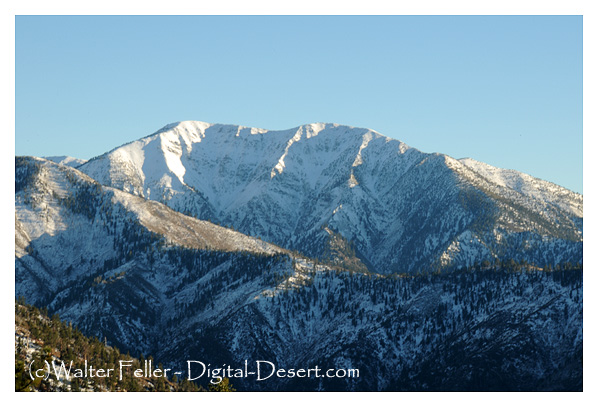Subsection M262Bd
San Gabriel Mountains

This subsection comprises the lower and warmer parts of the San Gabriel Mountains, which are between the San Andreas fault on the north-northeast and the Los Angeles and Fontana Plains on the south. It is bounded by the Soledad River valley on the northwest and the San Fernando Valley on the southwest and extend eastward to the Cajon Pass. The climate is hot to temperate, and subhumid. MLRA 20e.
Lithology and Stratigraphy. This subsection contains mostly Mesozoic granitic rocks and Pre-Cambrian anorthosite. Also, there is some Pre-Cretaceous Pelona schist.
Geomorphology. This is a subsection of steep and very steep mountains with narrow to rounded summits and narrow canyons. The mountains trend east-west, but hills along the San Andreas fault trend west-northwest. The subsection elevation range is from about 500 feet up to 6000 feet. Mass wasting and fluvial erosion are the main geomorphic processes.
Soils. The soils are mostly Lithic and shallow Typic Xerorthents, shallow Entic Haploxerolls, and Calcic Haploxerolls. Most of the soils, but not all, are leached free of carbonates. The soils are well drained. Soil temperature regimes are mostly thermic, and some mesic on north-facing slopes at higher elevations. Soil moisture regimes are xeric.
Vegetation. The predominant natural plant communities are Chamise series and Chamise - hoaryleaf ceanothus series, which are generally on shallow and very stony soils. Live oak chaparral series and Mixed chaparral shrublands also occur. Ponderosa pine series with some Bigcone Douglas-fir series and Bigcone Douglas-fir - canyon live oak series occurs on north-facing slopes, Jeffrey pine series occurs on the north-northeast side of the mountains, and California juniper series occurs on hills along the San Andreas fault.
- Characteristic series by lifeform include:
Grasslands: Beaked sedge series, Bur-reed series, California annual grassland series, Tufted hairgrass series.
Shrublands: Big sagebrush series, Bitterbrush series, Black bush series, Black sagebrush series, California buckwheat series, California buckwheat series, Chamise series, Chamise - bigberry manzanita series, Chamise - white sage series, Chamise - black sage series, Chamise - hoaryleaf ceanothus series, Chaparral whitethorn series, Cupleaf ceanothus - fremontia - oak series, Fourwing saltbush series, Hairyleaf ceanothus series, Hoaryleaf ceanothus series, Hop-sage series, Mixed saltbush series, Mixed scrub oak series, Mountain whitethorn series, Mulefat series, Nolina series, Parry rabbitbrush series, Scalebroom series, Scrub oak series, Scrub oak - chaparral whitethorn series, Shadscale series, White sage series.
Forests and woodlands: Birchleaf mountain-mahogany series, California juniper series, Coulter pine series, Coulter pine - canyon live oak series, Bigcone Douglas-fir series, Bigcone Douglas-fir - canyon live oak series, Canyon live oak series, Coast live oak series, Curlleaf mountain-mahogany series, Ponderosa pine series, Singleleaf pinyon series.
Surface Water. Runoff is rapid. All but the larger streams are dry through the summer. Natural lakes are absent, except along the San Andreas fault. There are some sag ponds along the San Andreas fault.
< previous - Southern California Mountains and Valleys - next >Angeles National Forest
Natural History of the San Gabriel Mountains
The San Gabriel Mountains are a rugged and picturesque mountain range located in Southern California, just northeast of Los Angeles. They have a rich natural history and provide a habitat for a wide variety of plant and animal species. Here is an overview of the natural history of the San Gabriel Mountains:Geology: The San Gabriel Mountains are part of the Transverse Ranges in California and were formed by the complex interactions of tectonic plates. The mountains are primarily composed of granitic rocks and are known for their steep canyons, high peaks, and rugged terrain.
Flora: The San Gabriel Mountains boast a diverse range of plant species, from chaparral and coastal sage scrub at lower elevations to coniferous forests at higher elevations. Common plant species include California oak trees, manzanita, ceanothus, bigcone Douglas fir, and Jeffrey pine. Wildflowers, such as California poppies and lupines, bloom during the spring, creating vibrant displays of color.
Fauna: The San Gabriel Mountains provide a home to a variety of wildlife, including mule deer, black bears, bobcats, mountain lions, gray foxes, and numerous bird species. The San Gabriel Mountains are also home to the California condor, a critically endangered bird species that has been the focus of extensive conservation efforts.
Recreation: The San Gabriel Mountains offer a wide range of outdoor recreational activities, including hiking, camping, rock climbing, and winter sports. The Pacific Crest Trail, which stretches from Mexico to Canada, runs through the range, attracting hikers and backpackers from all over.
Water Sources: The San Gabriel Mountains are an important source of water for the greater Los Angeles area. Several rivers and streams originate in the mountains, including the San Gabriel River, which provides drinking water, and the Santa Clara River. These water sources also support a variety of aquatic life.
Fire Ecology: Fire is a natural and essential part of the San Gabriel Mountains' ecosystem. Many plants in the region have adapted to and rely on periodic fires for their reproduction. While wildfires can be destructive, they also play a role in maintaining the health and diversity of the landscape.
Conservation: Efforts to conserve the natural beauty and ecological integrity of the San Gabriel Mountains are ongoing. The establishment of the San Gabriel Mountains National Monument in 2014 was a significant step in protecting the area's unique natural and cultural resources.
In summary, the San Gabriel Mountains have a fascinating natural history, including geology, diverse flora and fauna, and a rich cultural heritage. They offer opportunities for outdoor recreation and play a crucial role in providing water to the surrounding urban areas. Efforts to conserve and protect this remarkable mountain range are ongoing to ensure its continued ecological health and accessibility for future generations.